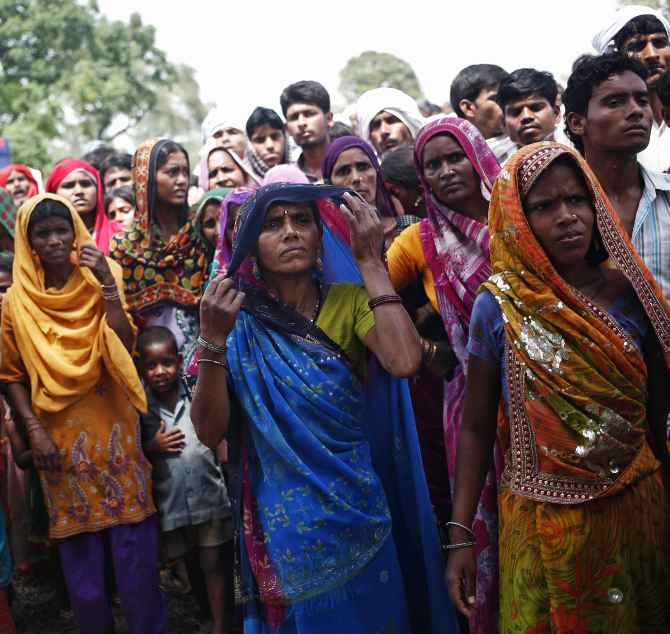Photographs: Anindito Mukherjee/Reuters Mayank Mishra
Below-par growth and a serious governance gap have ensured that on almost all social indicators UP trails and, by the state government's admission, matches levels of sub-Saharan Africa. Be it infant mortality, literacy or the sex ratio, UP is far behind others, notes Mayank Mishra.
Life in Uttar Pradesh is short and uncertain. A female expects to live less than 55 and the under-five mortality rate is 141 per 1,000. In these respects, UP resembles sub-Saharan Africa.
If a girl is born in Kerala she can expect to live 20 years longer than in UP. The probability she will die before one is over six times as high in UP.
This is stated in a government site profiling UP. The information has not been updated for years as is clear from the headline Uttar Pradesh: Economy in 50 years.
Life in UP seems uncertain going by the law and order situation. There have been reports of crime against women after the Badaun rape case. Three district Bharatiya Janata Party leaders have been killed and on June 15, and two constables were killed in Firozabad district. Eleven policemen lost their lives in two years and 100 were attacked.
Please …
247 incidents of communal violence in 2013 in UP
Image: A woman and her child, who were injured in the communal clashes, in a Muzaffarnagar hospital.Photographs: Reuters
UP has seen a rise in communal violence. According to reports, the state saw 247 incidents in 2013 and 118 in 2012. Reports suggest a rise in sexual violence and murder in recent years.
The police suffers from an acute manpower shortage and politicisation. According to reports, the state has one policeman for 1,234 people, below the national average of one for 733.
Nearly 60 per cent of state's 1,500 police stations are reportedly headed by officers of a particular caste. Sudhir Panwar, professor at Lucknow University, says, "This strikes at the root of discipline in the police force."
Please …
'Economic reforms didn't help the small and medium enterprises in UP'
UP's problems are not restricted to law and order. In nine years, it lagged the national average economic growth for six years and did marginally better in three. The differential in per capita income from the national average is 50 per cent.
Lucknow-based economist Arvind Mohan says, "There is a direct relation between growth in the state and the allocation from central resources. UP accounts for 18 per cent of the country's population. But its share in the Centre's resources has ranged between five and seven per cent in eight of first nine Plan periods."
The per capita central assistance to all states increased by 56 per cent on average between 2009-10 and 2011-12, but the rise was 21.7 per cent for UP.
Mohan says the economic reforms launched in 1991 did not help the state. "It is clear the reforms benefited large enterprises. UP has a predominance of small (600,000) and micro (three million) enterprises, which suffered because of the delay in launching rural- and human development-centric reforms."
Please …
Eight per cent of the state's children die before one
Image: A malnourished child stands next to her mother in UP's Lalitpur districtPhotographs: Reuters
Retarded economic growth is a cause and result of the current power crisis in the state.
On paper, the state has a shortfall of 2,000 megawatts, less than 20 per cent of its demand. But the situation on the ground is alarming. Noida and Ghaziabad, hubs of economic activities, suffer an average 10-12 hours of power cuts daily. Many villages do not get power for six hours a day.
The state's politicians are yet to realise development can attract voters. Panwar says, "While other states, including neighbouring Bihar, moved on, UP has seen religion- or caste-based politics in two decades. The bureaucracy, too, is divided. Neither politicians nor bureaucrats have been subjected to appraisals. They have instead undergone a loyalty appraisal."
Below-par growth and a serious governance gap have ensured that on almost all social indicators UP trails and, by the state government's admission, matches levels of sub-Saharan Africa. Be it infant mortality, literacy or the sex ratio, UP is far behind others. Eight per cent of the state's children die before one.






article